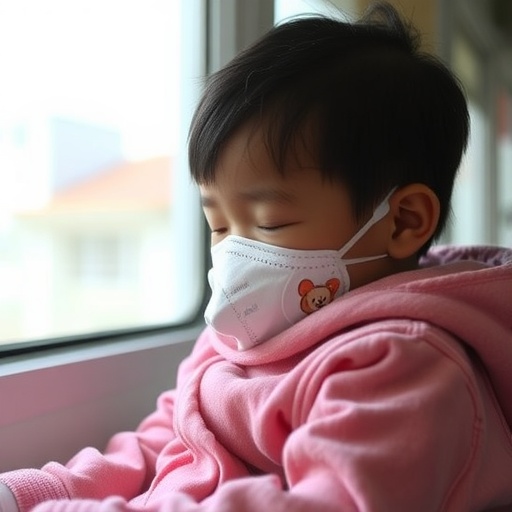During the COVID-19 pandemic, the practice of cardiopulmonary resuscitation (CPR) for children suffering out-of-hospital cardiac arrest (OHCA) witnessed profound and alarming shifts, as revealed by a groundbreaking study from researchers at Okayama University, Japan. This investigation, led by Dr. Takafumi Obara and his colleagues, delves into how fears surrounding viral transmission transformed life-saving pediatric CPR methods and the tragic consequences these changes wrought.
Cardiac arrest represents a sudden cessation of heart function, leading to an immediate stop in blood circulation and oxygen delivery to the brain and other vital organs. For pediatric patients, successful CPR entails a delicate balance of rescue breaths and chest compressions. Unlike many adult cases, where cardiac causes predominate, pediatric arrests often stem from respiratory failures induced by drowning, choking, or infectious illnesses, necessitating the integration of rescue breathing alongside compressions to restore oxygenation effectively.
Amid the global urgency of mitigating SARS-CoV-2 transmission, public health agencies issued revised guidelines recommending compression-only CPR (CO-CPR) for adults to minimize exposure risks. Though intended as a protective measure, this adaptation inadvertently extended into pediatric resuscitation practices. Fearful first responders, often family members, tended to omit rescue breaths during CPR, thereby reducing the efficacy of pediatric emergency intervention. The full scope and impact of this procedural shift remained insufficiently characterized until now.
To elucidate these trends and assess outcomes, the multidisciplinary Okayama team conducted an extensive analysis of Japan’s national pediatric OHCA registry data spanning 2017 to 2021. By comparing pre-pandemic CPR practices (2017–2019) with those implemented amid the pandemic (2020–2021), the researchers provided rigorous statistical insights into changes in CPR delivery types and their association with survival rates. This approach entailed meticulous data curation and multivariate analyses adjusting for confounding clinical variables, reflecting a methodologically robust epidemiological inquiry.
The study unveiled a dramatic decline in rescue breathing CPR (RB-CPR) rates among children, plummeting from 33.0% before the pandemic to just 21.1% during the crisis years. Conversely, chest compression-only CPR became increasingly prevalent among pediatric OHCA cases. While this shift aligned with global adult CPR recommendations, its application to pediatric populations ignored essential pathophysiological distinctions, resulting in diminished oxygen delivery during resuscitation and, consequently, weaker chances of survival.
Compounding the clinical concern, mortality analyses demonstrated that children receiving CO-CPR were statistically more likely to succumb within 30 days post-arrest, particularly in scenarios where cardiac arrest originated from non-cardiac causes such as asphyxia due to drowning or upper airway obstruction. These findings underscore the biological imperatives of tailored pediatric resuscitation, emphasizing oxygenation alongside circulatory support to optimize neurological and systemic outcomes.
Dr. Obara poignantly emphasized the societal gravity of pediatric cardiac arrest, highlighting that each life lost reverberates through families and communities. His team estimated that approximately 10 additional pediatric deaths per year in Japan could be attributed to the pandemic-induced decline in rescue breathing CPR. This stark number serves as a somber testament to the unintended mortality costs associated with altered emergency response behaviors during infectious disease outbreaks.
The analysis further revealed that the reduction in RB-CPR was consistent across all pediatric age brackets and was notably pronounced when family members—often the primary bystanders—administered CPR. This trend points to the psychological and informational barriers caregivers face in delivering effective pediatric resuscitation while balancing infection fears. The data call for urgent interventions aimed at equipping laypersons with both the skills and confidence needed to perform full CPR safely during pandemics and beyond.
In response, the authors advocate for comprehensive enhancements in pediatric CPR education. These improvements include expanding public access to evidence-based training programs that stress the critical importance of combining rescue breaths with chest compressions in children. Additionally, the promotion and dissemination of barrier devices such as pocket masks could alleviate infection transmission anxieties and create safer environments for bystander intervention.
This study’s findings bear profound implications for international CPR guidelines, underscoring that pandemic-driven recommendations for adult compression-only strategies cannot be indiscriminately applied to pediatric populations without risking increased mortality. The nuanced physiological demands of children necessitate refined protocols that balance infection control with lifesaving oxygenation strategies to maximize survival odds.
As Dr. Obara concluded, fostering a societal milieu where individuals feel empowered and protected to perform full pediatric CPR, including rescue breathing, could substantially reduce preventable deaths. Clear public health messaging, routine training refreshers, and ample distribution of protective equipment are essential pillars in cultivating this environment, ultimately preserving the lives of vulnerable children in emergency settings.
In light of these revelations, this pivotal research from Okayama University not only quantifies the collateral damage of altered CPR practices during COVID-19 but also charts a proactive path forward. It galvanizes healthcare professionals, policymakers, and communities alike to reaffirm the primacy of evidence-based pediatric resuscitation and to ensure preparedness for future public health crises without compromising the quality of emergency care.
The full study, titled “Compression only CPR and mortality in pediatric out-of-hospital cardiac arrest during COVID-19 pandemic,” was published in the journal Resuscitation on October 1, 2025, providing a critical resource for clinicians, emergency response systems, and health administrators worldwide aiming to optimize outcomes in pediatric emergency medicine.
Subject of Research: People
Article Title: Compression only CPR and mortality in pediatric out-of-hospital cardiac arrest during COVID-19 pandemic
News Publication Date: October 1, 2025
Web References:
https://doi.org/10.1016/j.resuscitation.2025.110706
Image Credits: Dr. Hiromichi Naito from Okayama University, Japan
Keywords:
Health and medicine, COVID 19, Cardiac arrest, Resuscitation, Pediatrics, Hospitals, Medical facilities, Patient monitoring, Public health, Viral infections




